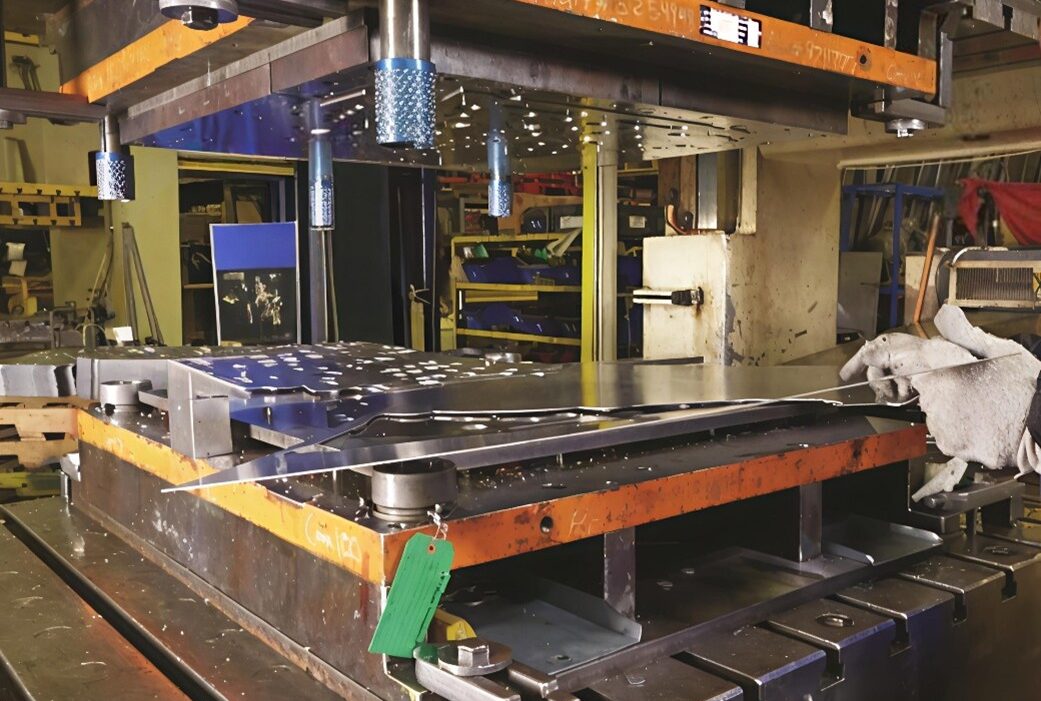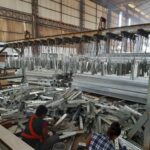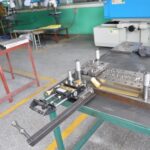Exploring The Science and Art of Progressive Stamping
Understanding Progressive Die Stamping: A Precision Manufacturing Technique
Progressive stamping is a remarkable process vital in today’s stamping manufacturing landscape. It empowers metal stamping companies to create precision metal products with exceptional accuracy and speed. If you’re curious about how those precision stamping parts in your car, electronic devices, or household appliances come to life, this exploration will enlighten you.
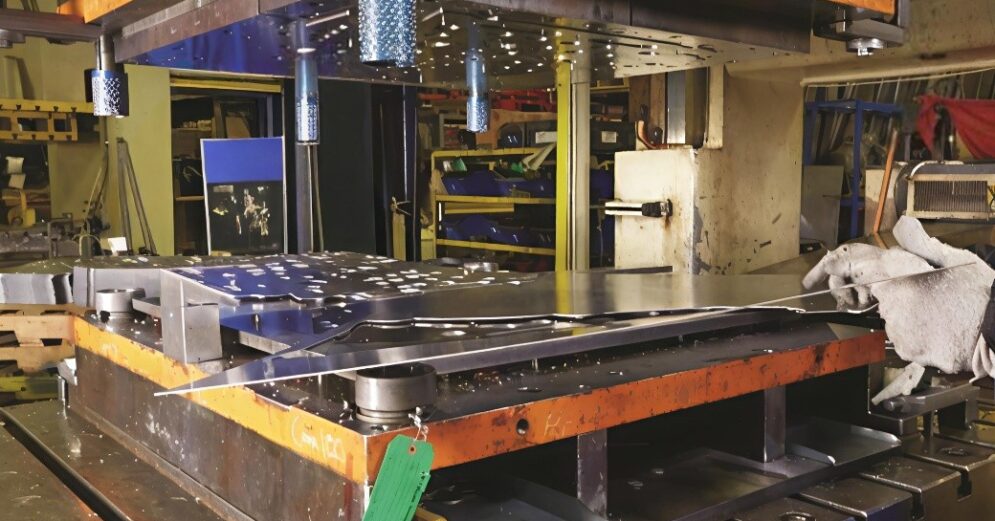
What is Progressive Die Stamping?
Progressive Die Stamping utilizes a series of specialized “stations” within a single die. As the metal stamping blank moves through each station, it undergoes different operations, such as cutting, bending, or shaping. By the time it emerges from the final station, it has miraculously transformed into the desired finished stamping parts. You’ll be amazed at how efficiently this process can turn out large quantities of parts, with some machines capable of producing up to 1,200 parts per minute!
The Precision of Progressive Die Stamping
Progressive die stamping stands out for its exceptional precision, allowing for precision stamping with incredibly tight tolerances and consistent repeatability. It can produce parts with tolerances as precise as ±0.001 inches. This high level of accuracy is essential in industries where even minor deviations can impact product performance and safety. For those working in stainless steel stamping, progressive die stamping offers the perfect solution. Stainless steel is notoriously tough to work with, but the controlled and incremental nature of this stamping manufacturing process makes it possible to produce intricate and precise stainless steel stampings. Whether you’re making automotive metal stampings or medical devices, progressive stamping ensures you get the consistency and quality you need.
Applications and Examples
Progressive die stamping is widely employed across various sectors.
At metal stamping shopfloors, it is used for producing parts ranging from clips to complex structural components, ensuring precision and durability in high-demanding environments.
In the electronics industry, progressive stamping is used to create stamping parts for smartphones and computers, maintaining tight tolerances for seamless component integration and optimal device performance.
Medical device manufacturers also rely on progressive die stamping to produce parts with the exacting standards required in the healthcare field. Whether it’s surgical instruments or components for medical equipment, the precision and repeatability of progressive stamping make it an ideal manufacturing method.
Precision and Quality Control
Precision stamping is crucial for progressive die stamping, as it ensures that each stamping part meets precise specifications. Typically, this process achieves tolerances of within ±0.001 inches, making it suitable for industries like automotive and aerospace where accuracy is vital. For instance, in automotive applications, parts like transmission components and brackets must adhere to tolerances stricter than ±0.002 inches to guarantee proper fit and operation. Progressive stamping employs advanced quality control techniques like in-die sensing and automated inspections. In-die sensors continuously monitor parameters like force and displacement, allowing for immediate detection of deviations from the desired range. Automated optical inspections, using advanced technology, can detect surface defects.
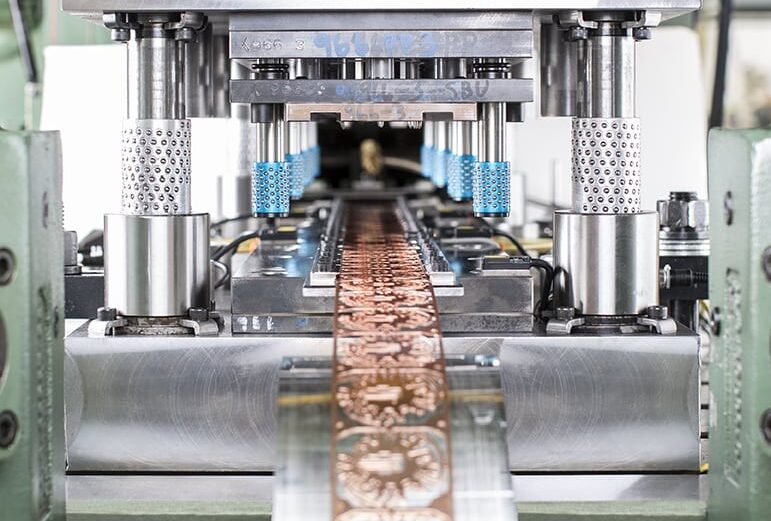
Advantages of Progressive Stamping Over Other Methods
In the realm of metal stamping, progressive stamping shines as a highly effective and accurate method. It surpasses other techniques, offering distinct advantages for various applications. From stainless steel stamping to crafting intricate metal stamping blanks and producing stamping parts for high-volume industries, progressive die stamping sets itself apart with its exceptional capabilities and precision. This article explores why progressive stamping is a key player in metal parts manufacturing.
Efficiency and Speed
Progressive stamping is known for its efficiency. It uses a continuous metal strip that goes through multiple stations, each performing a different operation. This allows for several operations to be done in one run, improving production efficiency. For instance, metal stamping companies use progressive die stamping to create up to 1,200 parts per minute, boosting output compared to traditional single-stage stamping methods. The efficiency of progressive stamping also results in faster production times. This is especially important in industries like automotive metal stamping and electronics, which demand high part volumes. Progressive stamping helps manufacturers meet deadlines and keep up with production demands. That’s the power of progressive stamping.
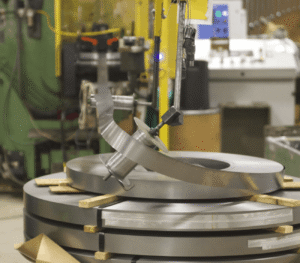
Precision and Consistency
Precision and Reliability in Progressive die Stamping – Progressive stamping stands out for its high precision. Each stage of the die is meticulously crafted to carry out specific tasks with extreme accuracy. This ensures that each part adheres to strict tolerances, often as precise as ±0.001 inches. Aerospace components frequently require tolerances as demanding as ±0.0005 inches to ensure optimal performance. Progressive die stamping can consistently meet these specifications, ensuring that every part is virtually identical. This reliability eliminates setbacks caused by variations in part dimensions.
Consistency is a major benefit of progressive stamping. Using the same die throughout ensures that every part is identical. This level of precision metal stamping is difficult to achieve with other methods that involve changes in stamping tools and setup, which can create inconsistencies in the final stamping parts.
For example, in stainless steel stamping, achieving consistent results is critical for ensuring the durability and performance of the parts in demanding environments. High-quality stainless steel stamping produced with progressive stamping, maintain their structural integrity and resistance to corrosion, crucial for applications such as surgical instruments and aerospace fasteners.
Additionally, progressive stamping is highly efficient, producing parts at impressive rates of up to 1,200 per minute. This makes it an ideal choice for mass production at stamping companies.
Cost-Effectiveness
Upfront costs for progressive stamping may be higher because of the intricate dies required. However, significant savings are achieved in the long run. The die’s durability allows it to produce millions of stamping parts with minimal upkeep, lowering the price per part, making this method cost-effective for stamping manufacturing. Furthermore, progressive die stamping minimizes material waste. The process is designed to maximize metal strip usage, reducing scrap rates below 5%. This resource efficiency not only lowers costs but also promotes sustainability in metal stamping. For metal stamping companies focused on the environment, this waste reduction is a major benefit.
Versatility and Flexibility
Progressive stamping stands out for its versatility, allowing it to produce a vast range of stamping parts with varying complexities. It can create everything from basic metal stamping blanks to intricate custom metal stamping components with multiple bends, holes, and features. Notably, progressive die stamping can work with materials ranging from 0.002 inches (0.051 mm) to 0.125 inches (3.175 mm) in thickness, making it suitable for diverse industries like automotive, aerospace, and consumer electronics. In the automotive sector, progressive stamping proves invaluable. It can create high precision metal stamping components while maintaining tight tolerances of ±0.001 inches (±0.0254 mm). ranging from large body panels to small, intricate parts, such as engine brackets and transmission parts.
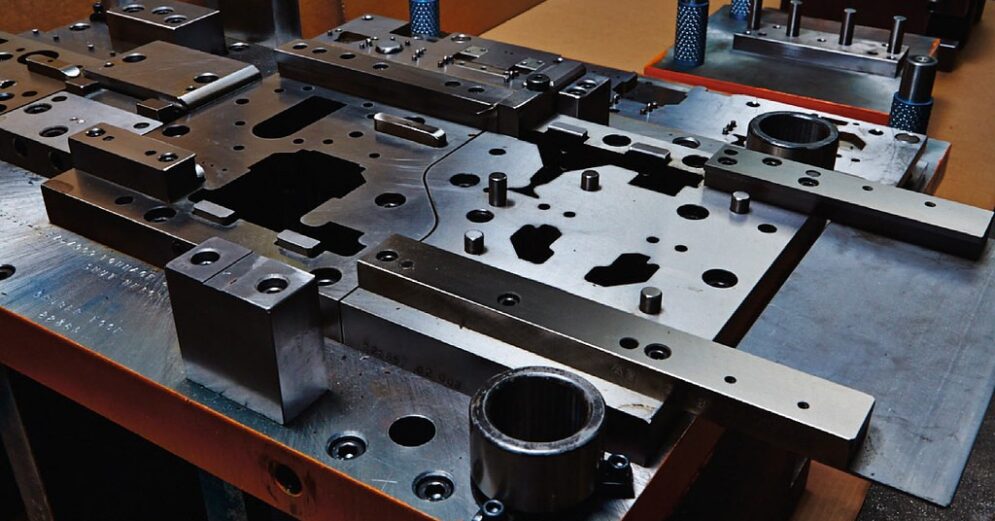
Adaptability to Various Materials and Specifications
A Progressive stamping set up has the adaptability to work with a wide range of materials and specifications. This includes:
- Material Thickness: From as thin as 0.002 inches (0.051 mm) to as thick as 0.125 inches (3.175 mm).
- Material Types: Including metals like stainless steel, aluminum, brass, and copper.
- Part Complexity: Able to produce parts with multiple bends, cutouts, and intricate geometries.
For example, in stainless steel stamping, achieving consistent results with a material known for its toughness is a testament to the precision and adaptability of progressive stamping.
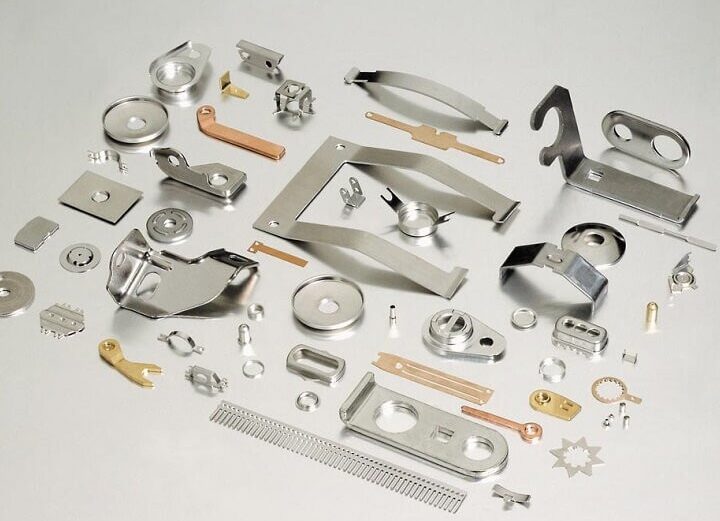
High-Quality Finish
Progressive stamping not only ensures precision and consistency but also achieves a superior high-quality finish. The process can seamlessly incorporate finishing operations such as coining, embossing, and perforating, all within the same die. This results in stamping parts that meet stringent specifications, often within tolerances of ±0.001 inches, and boast a smooth, professional finish with surface roughness as low as Ra 16 micro-inches. For engineering industries where aesthetics and surface quality are paramount, such as consumer electronics, the ability to produce high-quality finishes is a significant advantage.
Reduced Labor Costs
Automation is integral to progressive die stamping, where the process is highly automated to minimize manual intervention and human error. This approach can reduce labor costs by up to 20% compared to traditional methods. Notably, this automation improves part quality, ensuring that parts meet strict tolerances consistently. For metal stamping companies, embracing automation leads to significant operational efficiencies, lowering operating costs and increasing profitability by as much as 8% annually.
Real-World Applications and Success Stories of Progressive Die Stamping
Let’s explore some fascinating applications and success stories that highlight the versatility and ingenuity of progressive die stamping technology.
Automotive Innovations: Precision in Motion
To illustrate, let’s delve into an example from the automotive industry where progressive die stamping is indispensable. In today’s vehicle interiors, high-precision metal stamping is essential for crafting airbag components. Airbag housings and brackets demand precise dimensions to guarantee accurate deployment and safety in the event of an accident. For instance, brackets securing airbag modules must often maintain tolerances as stringent as ±0.001 inches to ensure dependable operation in crucial situations. Automakers rely on progressive stamping due to its ability to ensure uniformity and high production rates.
Aerospace Excellence: From Blueprint to Liftoff
Aerospace Precision through Progressive Stamping – In aerospace, where accuracy and reliability are essential, progressive die stamping plays a vital role. Manufacturers use this technique to create complex stamping parts like aircraft panels and wings. Specific techniques like deep drawing allow metal sheets to be shaped into intricate forms for aircraft parts. The ability to achieve exact shapes and dimensions within minuscule tolerances (often ±0.001 inches) is crucial for aerodynamic performance and structural stability. Additionally, using lightweight materials like aluminum metal stamping improves fuel efficiency.
Medical Device Manufacturing: Precision in Healthcare
In the medical device industry, precision is not just a preference—it’s a necessity. This industry demands the highest levels of accuracy and reliability, and progressive die stamping meets these rigorous standards for surgical instruments to diagnostic equipment.
Surgical Instruments: Precise Manufacturing. Surgical tools, such as forceps, scissors, and clamps, are often produced using stainless steel stamping. These instruments demand extremely tight tolerances (as small as ±0.0005 inches) to guarantee smooth operation and patient safety. By utilizing progressive die stamping, these precision metal products are made which is a necessity for the intricate nature of surgeries.

Diagnostic Equipment: Reliable and Consistent. Diagnostic equipment, including MRI machines and blood analyzers, requires precision metal stamping components that consistently adhere to strict specifications. Aluminum stamping is frequently used to fabricate lightweight and sturdy parts that fit precisely within complex assemblies. For instance, connectors and housings are made using this technique. For example, connectors and housings used in diagnostic devices require tolerances of ±0.001 inches to ensure reliable electrical connections and optimal performance. Progressive stamping enables the high-speed production of these sheet metal parts, maintaining consistent quality across large volumes.
For implantable medical devices, precision die stamping is essential. Stamping parts like pacemaker casings and orthopedic implants must meet strict biocompatibility and structural integrity standards. Materials such as titanium and stainless steel stamping are used for their strength and corrosion resistance. Manufacturing tolerances as tight as ±0.0002 inches ensure proper fit and function. The precision and repeatability of progressive stamping processes guarantee each metal stamping component meets stringent medical requirements.
Tips for Optimizing Progressive Stamping Processes
For any metal stamping service provider, refining progressive stamping processes is essential for superior product quality and increased production efficiency. Whether you’re working with stainless steel stamping, aluminum stamping, or creating intricate metal stamping blanks, fine-tuning your approach can make a world of difference. Here are some expert tips to help you get the most out of your progressive die stamping operations.
1. Embrace Advanced Stamping Design
To improve progressive stamping, it’s crucial to adopt sophisticated stamping designs. By utilizing techniques like 3D CAD software, metal stamping companies can design dies with precision, enabling them to anticipate potential problems before production. For example, Ford’s successful use of 3D CAD in designing door panels resulted in a 15% reduction in material waste, highlighting the effectiveness of advanced stamping design.
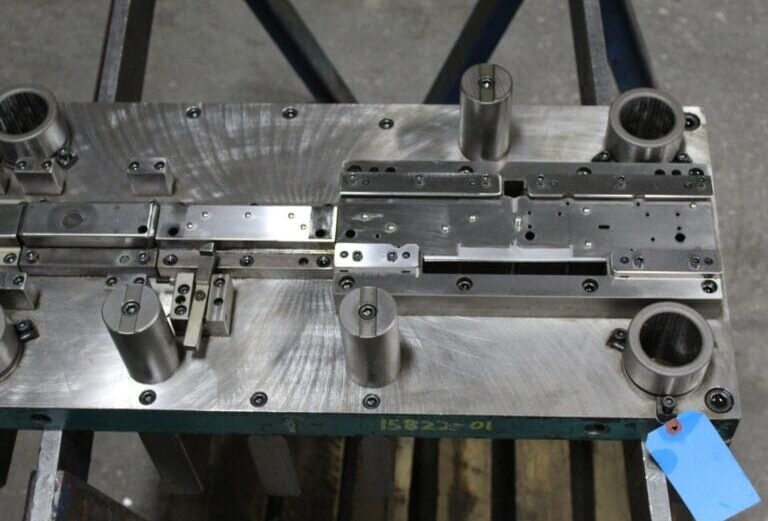
2. Choose the Right Materials
Material selection plays a crucial role in the success of progressive die stamping. Different materials have different properties that can affect the metal stamping process. For example, stainless steel stamping requires careful consideration of the material’s hardness and ductility. Using high-quality stainless steel ensures durability and resistance to corrosion, which is critical for stamping parts exposed to harsh environments. Similarly, aluminum stamping offers advantages in terms of weight reduction and ease of metal forming, making it ideal for applications requiring lightweight precision metal products.
3. Fine-Tune Your Stamping Tool
Your stamping tool is the heart of your progressive stamping process. Precision stamping requires precise tools that meet tolerances within ±0.001 inches. Using automated systems can detect wear and damage early on, allowing for repairs to prevent downtime and maintain tool efficiency. By keeping your stamping tool in excellent condition, you can consistently obtain high-quality precision metal products. For instance, in aerospace manufacturing, turbine blades are produced using stamping tools with tolerances as tight as ±0.0005 inches to ensure optimal performance and safety.
In the medical industry, stamping tools for intricate surgical instruments rely on automated monitoring to maintain precise dimensions within ±0.0002 inches, meeting stringent regulatory standards.
4. Optimize Production Parameters
Progressive die stamping performance hinges on meticulous control of key parameters:
- Press Speed: Higher speeds directly boost throughput, but necessitate reevaluation of lubrication to prevent excessive heat and tool wear.
- Stroke Length: Precise control ensures proper die engagement and complete metal forming within the stamping tool. Inappropriate settings can lead to incomplete forming or part damage.
- Lubrication: Selection and application are crucial for minimizing friction, heat, and tool wear. The strategy may require adjustments based on speed, material, and part complexity.
5. Implement Rigorous Quality Control
It’s essential to maintain rigorous quality control in progressive die stamping. Automated inspection systems, like laser scanning, precisely detect even the tiniest flaws in stamping parts. These systems can measure critical dimensions to within ±0.0005 inches, guaranteeing that only top-quality stamping parts advance in the production process.
6. Enhance Production Efficiency with Simulation Tools
Simulation tools have revolutionized progressive stamping by optimizing production processes and minimizing downtime. These tools use advanced algorithms to simulate the entire sheet metal stamping operation, predicting potential issues and optimizing tooling and material usage. For example, in aerospace, simulation tools are employed to enhance the manufacturing of intricate aircraft panels and structural components. By simulating the stamping process, manufacturers can optimize material flow and minimize waste, achieving cost-effective production while meeting stringent aerospace regulations for component integrity and performance.
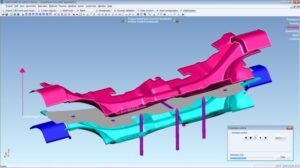
7. Invest in Employee Training
Offer workshops to your shop floor team covering advanced stamping design, tool maintenance, and quality control. By keeping your team up-to-date on industry trends and best practices, you can boost productivity and improve the quality of your metal stamping services. For instance, training your employees on advanced deep drawing techniques can lead to enhanced production of intricate parts, such as automotive hoods.
These tools simulate the entire metal stamping process, predicting problems and optimizing tooling and material usage.
Operators learn advanced techniques of progressive die stamping technology to set up and operate high-speed stamping presses, troubleshooting. They are also trained to interpret technical drawings and specifications accurately, ensuring that each stamped part meets stringent dimensional tolerances (often within ±0.002 inches).
Whether you’re producing automotive components, medical devices, or aerospace parts, mastering the art of progressive stamping will ensure your success in the competitive world of precision metal stamping.
